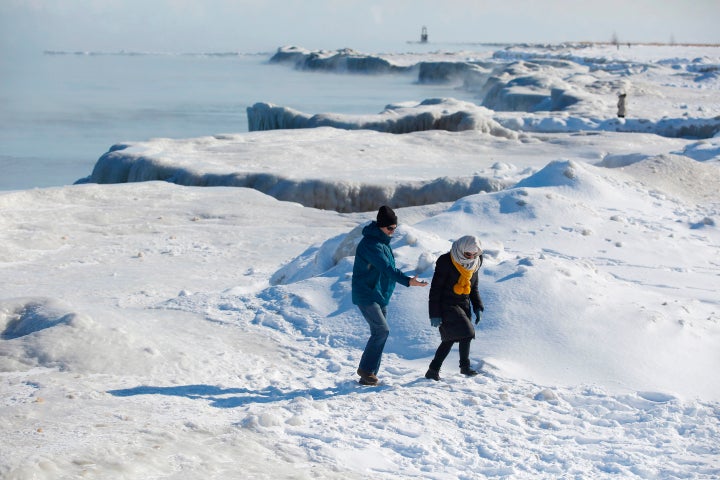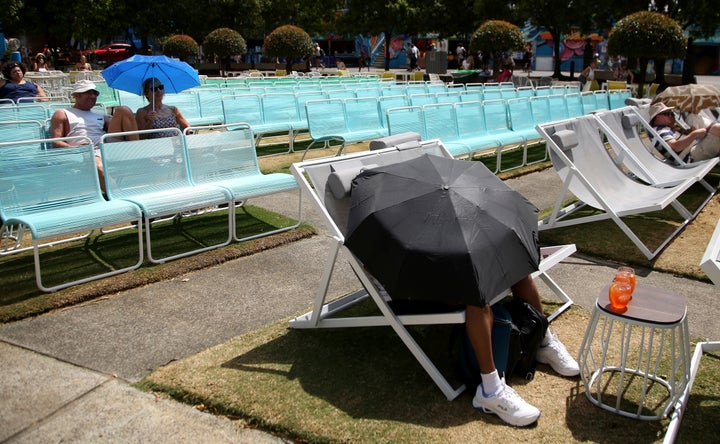In just a few weeks’ time, extreme temperatures have smashed records around the world this year, with parts of the Midwestern U.S. seeing the mercury drop as low as minus 38 degrees Fahrenheit as Australia endures triple-digit high temperatures, reigniting concerns about a changing planet.
At Chicago’s O’Hare International Airport, temperatures dipped to minus 23 degrees on Wednesday morning, breaking that day’s previous record low of minus 15, set in 1966. The lowest wind chill recorded Wednesday in Chicago was 52 degrees below zero, according to the National Weather Service.
Thursday’s forecast is not expected to be any better, with meteorologists forecasting a low of 27 degrees below zero, which would match the Chicago’s all-time record low.

The arctic blast has canceled hundreds of flights, closed major Chicago attractions and schools, and triggered states of emergencies by governors in Illinois, Wisconsin and Michigan. The U.S. Postal Service also suspended mail service on Wednesday for parts or all of several Midwestern states, including North and South Dakota, Nebraska, Kansas, Minnesota, Wisconsin, Iowa and Illinois.
Parts of Minnesota woke to some of the country’s coldest temperatures, with minus 38 degrees recorded in Melrose, Minnesota, on Wednesday morning. The nation’s coldest wind chill factor, minus 70, was reported in Ely, Minnesota.
The National Weather Service office near Minneapolis and St. Paul has urged residents to stay indoors if at all possible.
“These are VERY DANGEROUS conditions and can lead to frostbite on exposed skin in as little as five minutes where wind chill values are below -50,” the NWS tweeted. “Best thing you can do is limit your time outside.”
The good news for Minnesota is that temperatures are expected to rebound by 75 degrees between Thursday and Sunday, according to the National Weather Service’s Twin Cities bureau.
As cold as it is in parts of the U.S., in the southern hemisphere, extremely high temperatures and drought are breaking records in Australia, which recently experienced its hottest December on record.
Temperatures in South Australia’s capital of Adelaide hit nearly 116 degrees Fahrenheit last week, breaking an 80-year-old record high set in January 1939, according to the Bureau of Meteorology in South Australia. On Wednesday, Adelaide nearly topped 101 degrees.
Along with intense heat, the coastal capital is also facing its driest January in 62 years, with its last rainfall occurring six weeks ago, according to the weather bureau.
In Australia’s Northern Territory, a mass grave of 90 wild horses was found at a dried up watering hole near Santa Teresa. The animals are believed to have died of heat stroke or dehydration.
Last week, scientists also revealed that nearly one-third of Australia’s spectacled flying foxes, a type of fruit bat, was killed in a two-day heat wave in November. The bats are said to be unable to withstand temperatures over 107 degrees Fahrenheit. The number of deaths, approximate at 23,000, was finalized earlier this month, the BBC reported.
These extreme temperatures may be something to get used to.
Meteorologists expect Australia’s extreme heat to be part of a new trend, with minimum temperatures increasing over the last 50 years, according to the Bureau of Meteorology.
The bureau’s Global Temperature Report for 2018 found that Australia’s climate and its surrounding oceans have warmed by about 1.8 degrees Fahrenheit (or 1 degree Celsius) since 1910. Sea levels have also risen around Australia.
A review of global temperatures by the nonprofit research organization Berkeley Earth in California also determined that 2018 was likely the fourth warmest year on Earth since record-keeping began in 1850. The three warmest years recorded were in 2015, 2016 and 2017, with 2016 having been the warmest year seen.

“The slight decline in 2018 is likely to reflect short-term natural variability, but the overall pattern remains consistent with a long-term trend towards global warming,” the organization concluded.
On Tuesday, the Earth was measured at 0.54 degree (0.3 degree Celsius) warmer than the 1979 to 2000 average and 1.6 degrees warmer than it was on average about 100 years ago, The Associated Press reported, citing data taken from the University of Maine’s Climate Reanalyzer and NASA.
As for the extreme cold temperatures recorded in parts of the U.S., scientists argue that it’s just bad weather and not conflicting evidence of climate change, as President Donald Trump suggested Monday on Twitter.
“This is simply an extreme weather event and not representative of global-scale temperature trends,” Northern Illinois University climate scientist Victor Gensini told The Associated Press. “The exact opposite is happening in Australia right now.”
“In a warming world, you’re still going to have unusually hot and unusually cold events happening in a particular part of the world,” Berkeley Earth climate scientist Zeke Hausfather also told the AP. “Weather is not going away.”